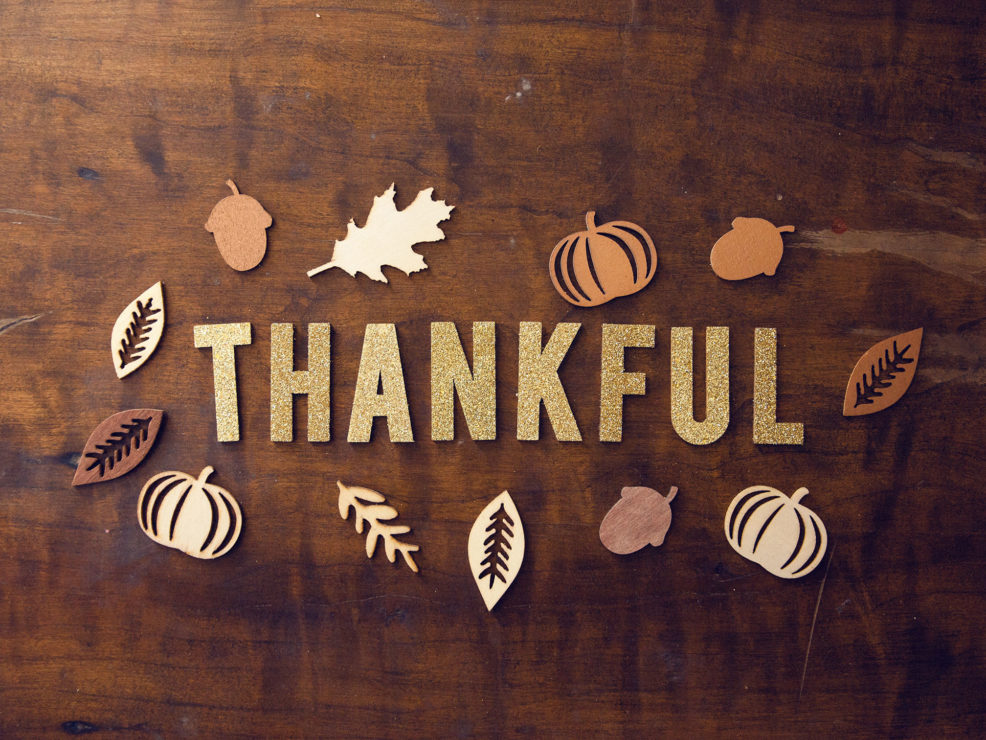Our fast-paced, consumer-driven world of the twenty-first century can often distract us from celebrating the true essence of the humble November holiday; Thanksgiving. Many of us will take some time to acknowledge what we are grateful for, but how many of us will simultaneously be distracted by “28 shopping days until Christmas”, Black Friday plans, or a big Cyber Monday purchase?
“The greatest gift one can give is thanksgiving. In giving gifts, we give what we can spare, but in giving thanks we give ourselves.” ~ Br. David Steindl-Rast
Definition: Thanksgiving: “grateful acknowledgment or expression of gratitude”.
So perhaps now is a good time to highlight the benefits of appreciation and some practical tools to cultivate this state of mind as a way to sustain a more mindful, stress-reduced, and present experience, this holiday season.
What exactly is gratitude and why is it so important? It comes from the Latin root “Grata” meaning “pleasing and thankful” (1). The definition of gratitude may vary depending on the discipline. However, most will agree on several qualities: appreciation and value in something, which is separate of monetary worth; it is a universal gift freely given in the present moment; an affirmation of goodness in the world; and recognition that the source of goodness is outside ourselves – whether it is other people, higher power, or nature. To experience life in such a way has been a focal point for centuries across religions, philosophy, and even modern psychology and health studies.
Robert Emmons, a leading psychologist in the study of gratitude, believes that based upon many publications out of his lab, and those who have replicated their work, gratitude has the power to do three things: to heal, to energize, and to change lives (3). Research has found that individuals who regularly practice gratitude display a wide range of benefits (4), including:
- Stronger immune system
- Lower blood pressure
- Improved sleep
- Less pain
- Lower stress
- Feeling more alive and alert
- More joy and happiness
- More forgiveness
- Less lonely and feeling of isolation
- More compassion
Perhaps one of the best things about gratitude is that it’s free and available to you every day of the year. If the benefits weren’t motivation enough, learning how simple and easy it is to be intentionally grateful every day, you will be able to see for yourself the power of gratitude.
How to Cultivate Gratitude in Your Life
Start an appreciation journal. Create a daily practice to reflect on all you have to be grateful for: opportunities, love, gifts, forgiveness, and other good things you may enjoy. Work on being specific, and detailing a particular moment or trait of a family member, rather than stating “ I am grateful for my family” every day. Giving specific details allows for deeper connection, and expands the practice.
Consider meditation. Whether you use a formal meditative practice, such as loving-kindness, or facilitate a quiet intentional space to experience apprecation–this is a great way to deepen a gratitude practice and reduce stress.
Take account of the little things. Observe all of the factors that go into your day. Your body and its ability to function throughout the day, all that goes into having meals, a working vehicle and or technology that allows for transportation, etc. Taking a moment to observe all that must go right is a simple way to reframe towards gratitude. This is a great place to start with kids. Get creative.
Learn prayers of gratitude. If you have a spiritual or religious practice this can be a very meaningful and sustainable practice of gratitude.
Tell somebody you appreciate them, daily. Eventually, you can even try this with someone you might struggle with, and see how it transforms the relationship.
Be mindful of all who serve you in some way. Find time to wholeheartedly express gratitude for them.
Remember negative, or trying times. By doing this you create a contrast in your mind, which allows gratitude for where you are now, and what it took to overcome or achieve what you have today.
Be creative and personal. Explore new ways to find and express appreciation. Find practices that resonate with you and can be sustainable. There are no right or wrong ways to cultivate gratitude. A personal unique practice is encouraged and will likely keep you coming back.
Contact Valley Schools today!
References:
- Oxford Dictionary (n.d.) Definition of gratitude. Retrieved from https://www.lexico.com/en/definition/gratitude
- Elfers, J., & Hlava, P. (2016). The Lived Experience of Gratitude. In The Spectrum of Gratitude Experience(pp. 31-47). Palgrave Macmillan, Cham.
- Emmons, R. [Greater Good Science Center] (2010). The power of gratitude. [Video file] Retrieved from https://www.youtube.com/watch?v=jLjVOvZufNM
- Emmons, R (2010). Why gratitude is good. Retrieved from: https://greatergood.berkeley.edu/article/item/why_gratitude_is_good

